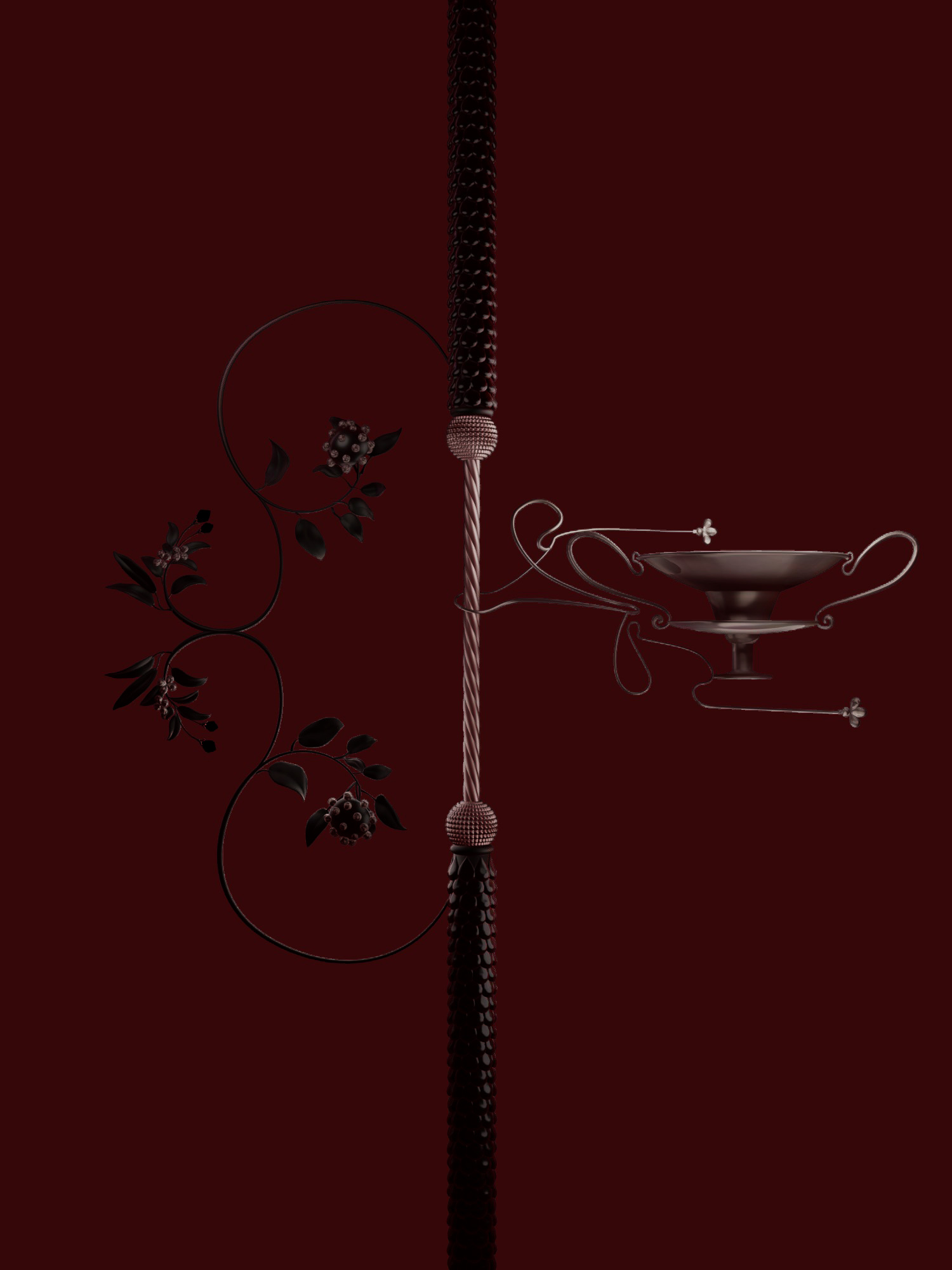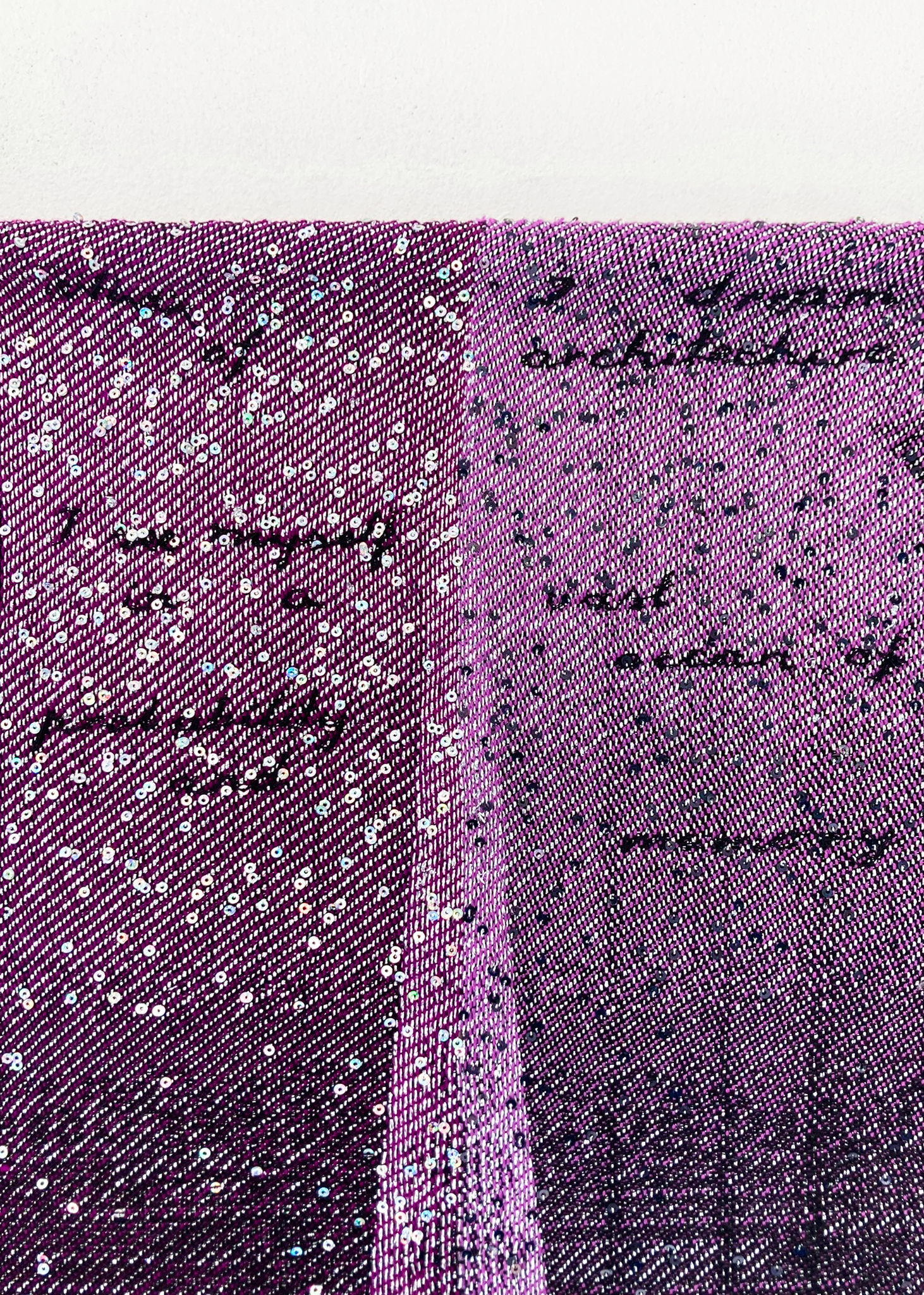List of Previous Works (Selected)
![]()
![]()
Delicate Frescoes, digital
The image was designed based on ancient Pompeiian Third Style Frescoes, a style of painting that took traditional elements of architecture but made fictional versions, often using flora, fauna and ethereal objects in their pictorial construction. By interpreting the painted elements through three-dimensional rendering the scene takes on a new layer of depth and dimension, articulating the scene through a new world.
![]()
![]()
Deep Dream Figures, digital
As an exploration into the lost stories of the frescoes, a series of digital experiments were done using AI including Deep Dream, an AI that detects faces and objects through pixel clusters in images, to try to understand more contemporary meanings through the ancient paintings. By taking the frescoes of the villa and reiterating the Deep Dream simulation on the image over 50 times (images left), a new series of characters began to emerge. These abject, grotesque figures are placed back into the original villa to build new digital stories.
The film compilations (4 min) explore the site of the Villa of Mysteries re-envisioned through photogrammetry software, deep dream figures of the site situated in room 5 of the villa, and the frescoes of Pompeii conceptualised as three-dimensional space.
![]()
![]()
Frescoes as Architecture, digital
Frescoes of the Villa of Mysteries reenvisioned as architectural environments through digital rendering and modelling.
![]()
![]()
left: The Domina’s Fresco, digital print
right: The Domina’s Building, 3D print, metal, 70x70x160cm
The translated story for the seated Domina featured by the entry of the frieze describes a dominatrix warrior refugee who builds a teardrop-shaped temple for her and others like her. The building was designed in collaboration with AI programs open.ai and dall-e.
![]()
![]()
The Domina’s Tapestry, tencel, sequin & cotton thread, 200x110cm.
The Domina’s Tapestry was made on the jacquard loom for the domina/dominatrix, the revised story for one of the painted figures in the Villa of Mysteries. The tapestry depicts elements of her new architectural environment, designed in collaboration with AI and references to her archaeological site.


Delicate Frescoes, digital
The image was designed based on ancient Pompeiian Third Style Frescoes, a style of painting that took traditional elements of architecture but made fictional versions, often using flora, fauna and ethereal objects in their pictorial construction. By interpreting the painted elements through three-dimensional rendering the scene takes on a new layer of depth and dimension, articulating the scene through a new world.


Deep Dream Figures, digital
As an exploration into the lost stories of the frescoes, a series of digital experiments were done using AI including Deep Dream, an AI that detects faces and objects through pixel clusters in images, to try to understand more contemporary meanings through the ancient paintings. By taking the frescoes of the villa and reiterating the Deep Dream simulation on the image over 50 times (images left), a new series of characters began to emerge. These abject, grotesque figures are placed back into the original villa to build new digital stories.
The film compilations (4 min) explore the site of the Villa of Mysteries re-envisioned through photogrammetry software, deep dream figures of the site situated in room 5 of the villa, and the frescoes of Pompeii conceptualised as three-dimensional space.


Frescoes as Architecture, digital
Frescoes of the Villa of Mysteries reenvisioned as architectural environments through digital rendering and modelling.


left: The Domina’s Fresco, digital print
right: The Domina’s Building, 3D print, metal, 70x70x160cm
The translated story for the seated Domina featured by the entry of the frieze describes a dominatrix warrior refugee who builds a teardrop-shaped temple for her and others like her. The building was designed in collaboration with AI programs open.ai and dall-e.


The Domina’s Tapestry, tencel, sequin & cotton thread, 200x110cm.
The Domina’s Tapestry was made on the jacquard loom for the domina/dominatrix, the revised story for one of the painted figures in the Villa of Mysteries. The tapestry depicts elements of her new architectural environment, designed in collaboration with AI and references to her archaeological site.


left: The Bride’s Fresco, digital print
right: The Bride’s Mirror, brass, 265x140mm
The translated story for the Bride in the Villa of Mysteries and her mirror inspired by ancient Etruscan Mirrors. The illustrations depict visions of the Bride’s experience as she transitions from human to divine being during her marriage ceremony to Eros, God of Love. The building and her mirror were designed in collaboration with AI programs open.ai.
right: The Bride’s Mirror, brass, 265x140mm
The translated story for the Bride in the Villa of Mysteries and her mirror inspired by ancient Etruscan Mirrors. The illustrations depict visions of the Bride’s experience as she transitions from human to divine being during her marriage ceremony to Eros, God of Love. The building and her mirror were designed in collaboration with AI programs open.ai.


left: The Kneeling Woman’s Tablet, marble, brass, silicone, metal stand
Marble, brass, silicone, metal stand,
50x20x10cm
right: The Kneeling Woman’s Fresco, digital
The translated story for the Kneeling Woman in the Villa of Mysteries as a queer cyberfeminist woman. She exists in a womb-like computerised structure that she sees as her mother. The marble tablet and fleshy keyboard are her instruments to speak to the machine about her existence in the liminal space of her queer internet world. The building and her tablet were designed in collaboration with AI programs open.ai.
Stuck in the Motherboard, film (7 min)
Working with AI to generate new identities for figures in the Villa of Mysteries, the work aims to translate our patriarchal histories to build new queer cyberfeminist perspectives that can live beyond the walls of the ancient fresco. In the film, Stuck in the Motherboard, the kneeling woman is an artist trapped inside of an egg-shaped computer that she sees as her mother. She reviews her life as she speaks towards her mother in the computer womb, gazing at the fractal stream of screens surrounding her.
As a queer asian woman, the designs take on elements from personal experience. The Kneeling Woman wears a cheongsam and exists in a hyper-real fluid dreamscape of screens showing different versions of herself reflects on personal experiences being mixed but wanting to find a sense of belonging to my asian heritage, and feeling more connected when existing online. The project explores the softscape of the digital and the opportunity to feel connected to all aspects of your identities on the internet. It is a visual investigation into how we can critically perceive our digital identities and design new spaces for our gender fluid, transversally thinking, physically-transcending bodies to exist.
right: The Kneeling Woman’s Fresco, digital
The translated story for the Kneeling Woman in the Villa of Mysteries as a queer cyberfeminist woman. She exists in a womb-like computerised structure that she sees as her mother. The marble tablet and fleshy keyboard are her instruments to speak to the machine about her existence in the liminal space of her queer internet world. The building and her tablet were designed in collaboration with AI programs open.ai.
Stuck in the Motherboard, film (7 min)
Working with AI to generate new identities for figures in the Villa of Mysteries, the work aims to translate our patriarchal histories to build new queer cyberfeminist perspectives that can live beyond the walls of the ancient fresco. In the film, Stuck in the Motherboard, the kneeling woman is an artist trapped inside of an egg-shaped computer that she sees as her mother. She reviews her life as she speaks towards her mother in the computer womb, gazing at the fractal stream of screens surrounding her.
As a queer asian woman, the designs take on elements from personal experience. The Kneeling Woman wears a cheongsam and exists in a hyper-real fluid dreamscape of screens showing different versions of herself reflects on personal experiences being mixed but wanting to find a sense of belonging to my asian heritage, and feeling more connected when existing online. The project explores the softscape of the digital and the opportunity to feel connected to all aspects of your identities on the internet. It is a visual investigation into how we can critically perceive our digital identities and design new spaces for our gender fluid, transversally thinking, physically-transcending bodies to exist.